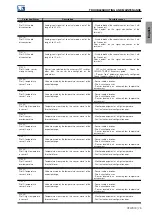
English
TROUBLESHOOTING AND MAINTENANCE
Protection/Alarm
Description
Possible causes
A135:
CANopen Off-line
It occurs if the state of the CANopen node changes
from operational to pre-operational.
Note:
- Check the operation of the error control
mechanisms (Heartbeat/Node Guarding).
- The master is not sending the guarding/heartbeat
telegrams at the programmed time.
- Communication problems caused by lost telegrams
or transmission delays.
A136:
Master in Idle
It actuates when communicating with the DeviceNet
network master in Run mode, and transition to Idle
mode is detected.
- Set the switch that controls the master operation
of the master to Run or the corresponding bit on the
configuration word of the master software. For further
explanations, see the documentation of the master in
use.
A137:
DeviceNet connection
timeout
It indicates that one or more DeviceNet I/O
connections has expired.
It occurs when, for some reason, after the cyclical
communication between the master and the product
has started, this communication is interrupted.
- Check the status of the network master.
- Check network installation, broken cable or
fault/poor contact on the connections with the
network.
A145:
SNTP Connection
Timeout
It indicates that the inverter tried to connect to the
NTP server and got no response.
It occurs when, for some reason, after starting
connection with the NTP server, the server did not
return the response requested by the inverter.
Check configuration and IP address.
Check if the NTP server is still active.
A149:
Timeout Modbus TCP
It indicates that the device stopped receiving valid
telegrams for a period longer than the setting in
C9.6.3.
The time counting starts as soon as it receives the
first valid telegram.
- Check network installation, broken cable or
fault/poor contact on the connections with the
network, grounding.
- Ensure the Modbus TCP client always sends
telegrams to the equipment in a time shorter than the
setting in C9.6.3.
- Disable this function in C9.6.3.
F150:
Motor Overspeed
Overspeed fault.
Note:
- Activated when the actual speed exceeds the value
of C4.3.1.1.2 x (100 % + C7.7.1) for more than 20
ms.
- Incorrect setting of C3.3.2.1.2 and/or C3.3.2.1.3.
- Crane-type load trips.
A152:
Pow.Int. Air Overtemp.
High internal air temperature alarm.
Note:
- The alarm can be disabled by setting C7.5.1.
- High ambient temperature around the inverter (>50
◦
C) and high output current.
- Defective internal fan (when applicable).
F153:
Pow.Int. Air Overtemp.
Internal air overtemperature fault.
- High ambient temperature around the inverter (>50
◦
C) and high output current.
- Defective internal fan (when applicable).
A154:
Cont.Int.Air Overtemp.
Control circuit high temperature alarm.
Note:
- The alarm can be disabled by setting C7.5.1.
- High ambient temperature around the inverter (>50
◦
C) and high output current.
- Locked or defective fan.
- Inverter heat sink too dirty.
F155:
Cont.Int.Air Overtemp.
Control circuit overtemperature fault.
- High ambient temperature around the inverter (>50
◦
C) and high output current.
- Locked or defective fan.
- Inverter heat sink too dirty.
A156:
IGBT undertemperature
Alarm of undertemperature measured by the sensors
in the IGBTs, rectifier, power and/or control below -30
◦
C.
Note:
- The alarm can be disabled by setting C7.5.1.
- Ambient temperature around the inverter
≤
-30
◦
C.
CFW900 | 63
Summary of Contents for CFW900
Page 2: ......
















































